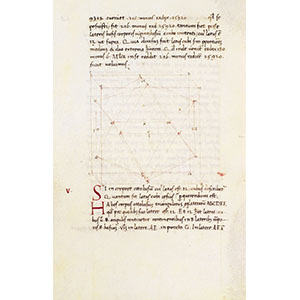Piero della Francesca, Libellus de quinque corporibus regularibus (facsimile)
Two Latin translations of Archimedes circulated in the 15th century, one by William of Moerbeke and the other by Jacopo of Cremona. This enabled many scholars to approach Archimedes' work. Humanists and artists such as Piero della Francesca and Luca Pacioli also studied the texts of Archimedes. Both studied the regular polyhedrons which were drawn by Leonardo da Vinci in Pacioli's De divina proportione (1497). In this treatise, Piero della Francesca argues a world characterised by the presence of complex bodies that can be traced back to the five regular polyhedrons, which represent eternal and perfect form. The polyhedrons were drawn in stereometric form for the first time. Known from the early 16th century, this text was the focus of fiery dispute after Luca Pacioli published it as his own work in 1509.



